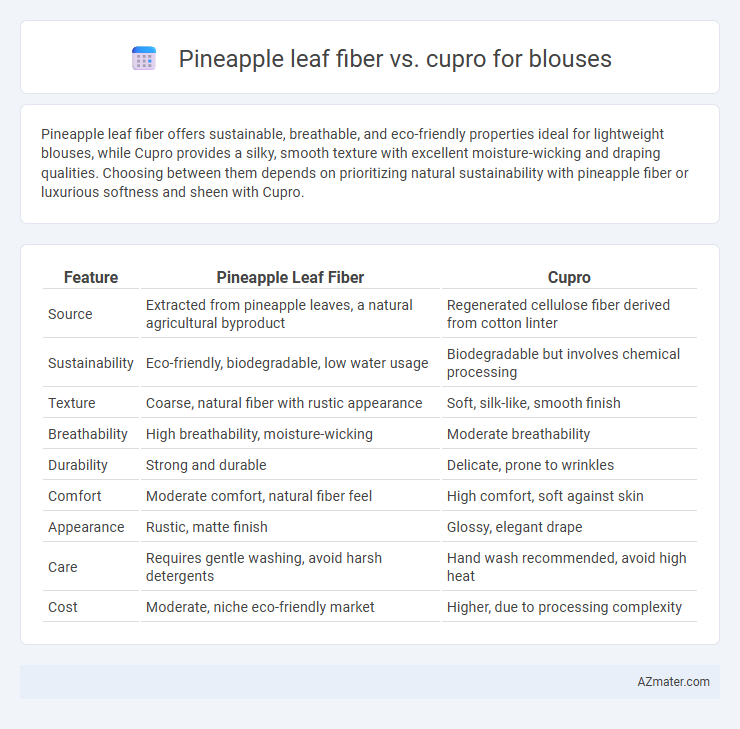Pineapple leaf fiber offers sustainable, breathable, and eco-friendly properties ideal for lightweight blouses, while Cupro provides a silky, smooth texture with excellent moisture-wicking and draping qualities. Choosing between them depends on prioritizing natural sustainability with pineapple fiber or luxurious softness and sheen with Cupro.
Table of Comparison
| Feature | Pineapple Leaf Fiber | Cupro |
|---|---|---|
| Source | Extracted from pineapple leaves, a natural agricultural byproduct | Regenerated cellulose fiber derived from cotton linter |
| Sustainability | Eco-friendly, biodegradable, low water usage | Biodegradable but involves chemical processing |
| Texture | Coarse, natural fiber with rustic appearance | Soft, silk-like, smooth finish |
| Breathability | High breathability, moisture-wicking | Moderate breathability |
| Durability | Strong and durable | Delicate, prone to wrinkles |
| Comfort | Moderate comfort, natural fiber feel | High comfort, soft against skin |
| Appearance | Rustic, matte finish | Glossy, elegant drape |
| Care | Requires gentle washing, avoid harsh detergents | Hand wash recommended, avoid high heat |
| Cost | Moderate, niche eco-friendly market | Higher, due to processing complexity |
Introduction to Sustainable Blouse Fabrics
Pineapple leaf fiber offers a sustainable alternative for blouses due to its biodegradability and minimal environmental impact during production, utilizing agricultural waste from pineapple farming. Cupro, a regenerated cellulose fabric derived from cotton linter, provides a silky texture that is biodegradable and less resource-intensive compared to conventional synthetic fibers. Both fabrics contribute to eco-friendly fashion by reducing reliance on non-renewable resources and supporting circular textile practices.
Overview: Pineapple Leaf Fiber and Cupro
Pineapple leaf fiber is a sustainable, natural textile derived from the leaves of pineapple plants, known for its durability, breathability, and eco-friendly cultivation process. Cupro is a regenerated cellulose fabric made from cotton linter, offering a silky texture, excellent drape, and moisture-wicking properties. Both materials provide unique benefits for blouse fabrics, with pineapple leaf fiber emphasizing sustainability and strength, while cupro excels in softness and smooth appearance.
Production Process: Pineapple Leaf Fiber
Pineapple leaf fiber production involves extracting fibers from the leaves through a mechanical decortication process, followed by drying and softening to enhance texture for blouse fabrics. This eco-friendly method utilizes agricultural waste, making it sustainable and biodegradable compared to synthetic alternatives. The resulting material offers natural breathability and durability, ideal for lightweight, breathable blouses.
Production Process: Cupro
Cupro production involves dissolving cotton linter cellulose in a copper-ammonia solution to create a smooth, biodegradable fabric with a silky texture. This regenerated fiber undergoes filtration, spinning, and washing, ensuring uniformity and softness ideal for delicate blouses. Cupro's eco-friendly production emits fewer pollutants compared to synthetic fibers, supporting sustainable fashion initiatives.
Environmental Impact Comparison
Pineapple leaf fiber is a sustainable textile derived from the agricultural waste of pineapple plants, offering biodegradability and low water consumption during production. Cupro, a regenerated cellulose fiber made from cotton waste, involves a chemical-intensive process but benefits from recycling cotton byproducts, reducing landfill waste. Compared to Cupro, pineapple leaf fiber has a lower environmental impact due to its natural origin and minimal processing requirements, making it a greener choice for eco-conscious blouses.
Fabric Feel and Comfort Analysis
Pineapple leaf fiber fabric offers a distinctive textured feel with moderate breathability, providing a natural, eco-friendly option that is slightly coarser but durable, ideal for casual blouses. Cupro, a regenerated cellulose fiber derived from cotton linter, delivers a silky, smooth texture that mimics silk's luxurious softness and excellent drape, enhancing comfort in warm weather. In terms of comfort, Cupro excels with superior moisture absorption and breathability, making it more suitable for sensitive skin and prolonged wear compared to the more rigid, less pliable pineapple leaf fiber.
Durability and Care Requirements
Pineapple leaf fiber offers higher durability for blouses due to its strong, naturally stiff fibers resistant to wear and tear, making it suitable for long-lasting garments. Cupro, a regenerated cellulose fiber derived from cotton linter, has a delicate texture requiring gentle care, including hand washing or dry cleaning, to maintain its silky finish. Pineapple leaf fiber blouses demand minimal maintenance with better moisture resistance, while Cupro garments need cautious handling to prevent shrinkage and fabric weakening.
Aesthetic Qualities and Versatility
Pineapple leaf fiber blouse fabric offers a unique, natural texture with a subtle sheen, creating an eco-friendly and rustic aesthetic perfect for casual and bohemian styles. Cupro fabric provides a smooth, silk-like finish with excellent drape, lending a luxurious and elegant appearance ideal for formal or sophisticated blouse designs. Versatility is higher in Cupro due to its softness and breathability, accommodating diverse styling needs, while pineapple leaf fiber excels in sustainability and distinctive tactile appeal.
Cost and Market Availability
Pineapple leaf fiber blouses are generally more affordable due to the low-cost, sustainable raw material sourced from pineapple agriculture byproducts, with growing availability primarily in eco-conscious markets. Cupro blouses tend to be pricier, as this regenerated cellulose fabric involves a more complex production process and is widely available in premium and designer fashion sectors. Market availability for pineapple leaf fiber remains niche but expanding, while Cupro is more established with broader distribution across international fashion retailers.
Which is Better for Blouses?
Pineapple leaf fiber offers exceptional durability, breathability, and eco-friendliness, making it ideal for sustainable blouses with a natural texture. Cupro, derived from cotton waste, provides a silky, smooth feel and excellent drape, enhancing blouse comfort and elegance. For blouses prioritizing sustainability and durability, pineapple leaf fiber is better, while Cupro suits those seeking luxurious softness and fluidity.

Infographic: Pineapple leaf fiber vs Cupro for Blouse
 azmater.com
azmater.com